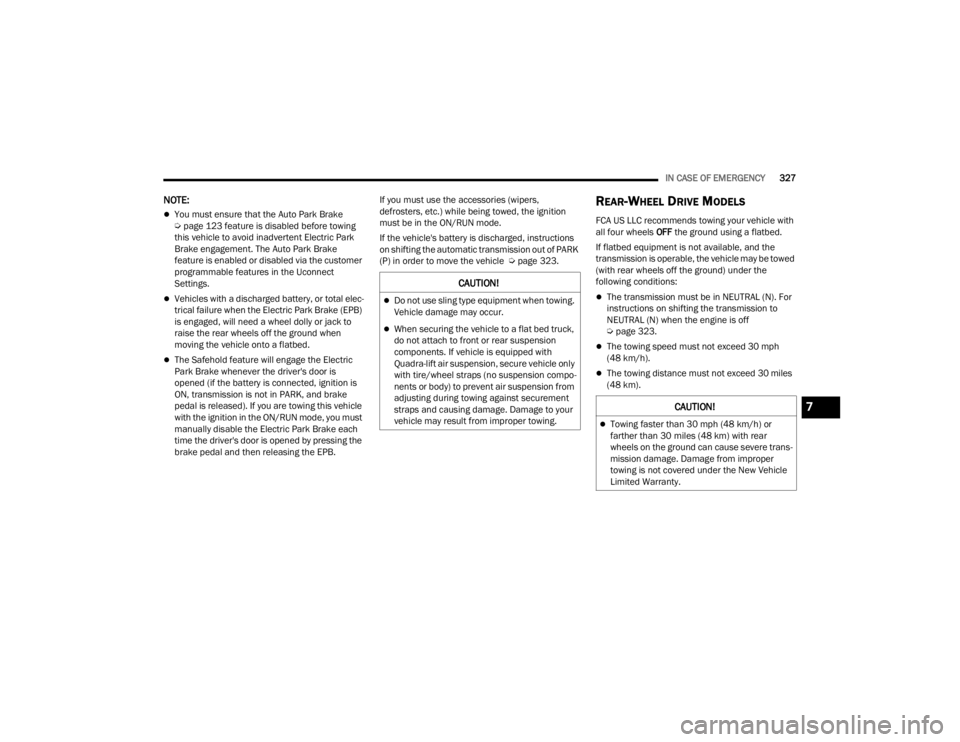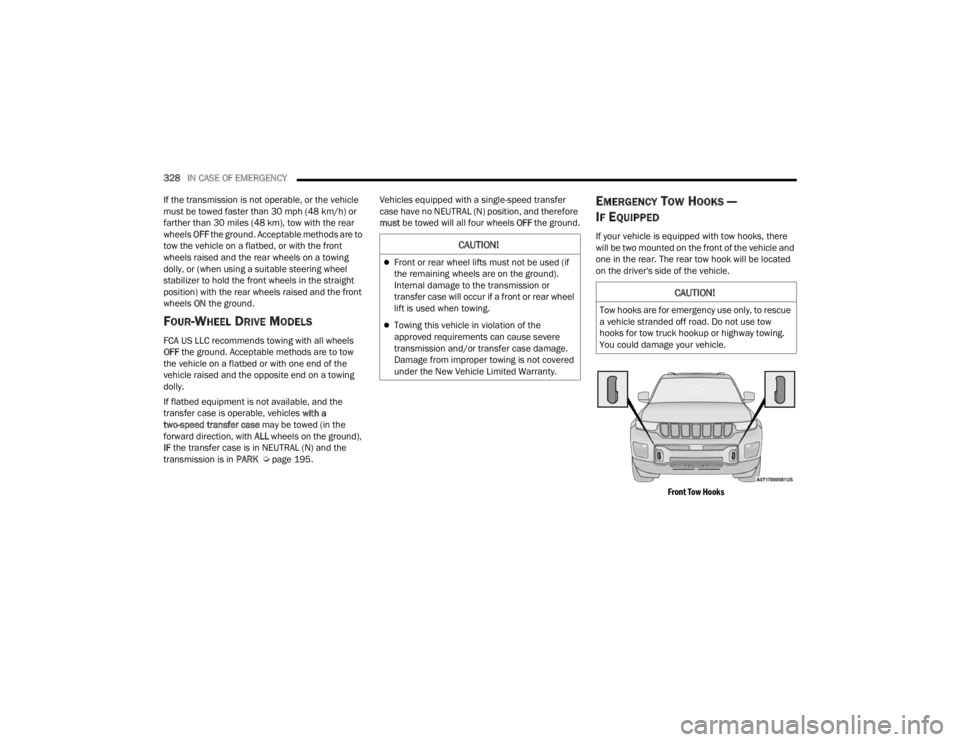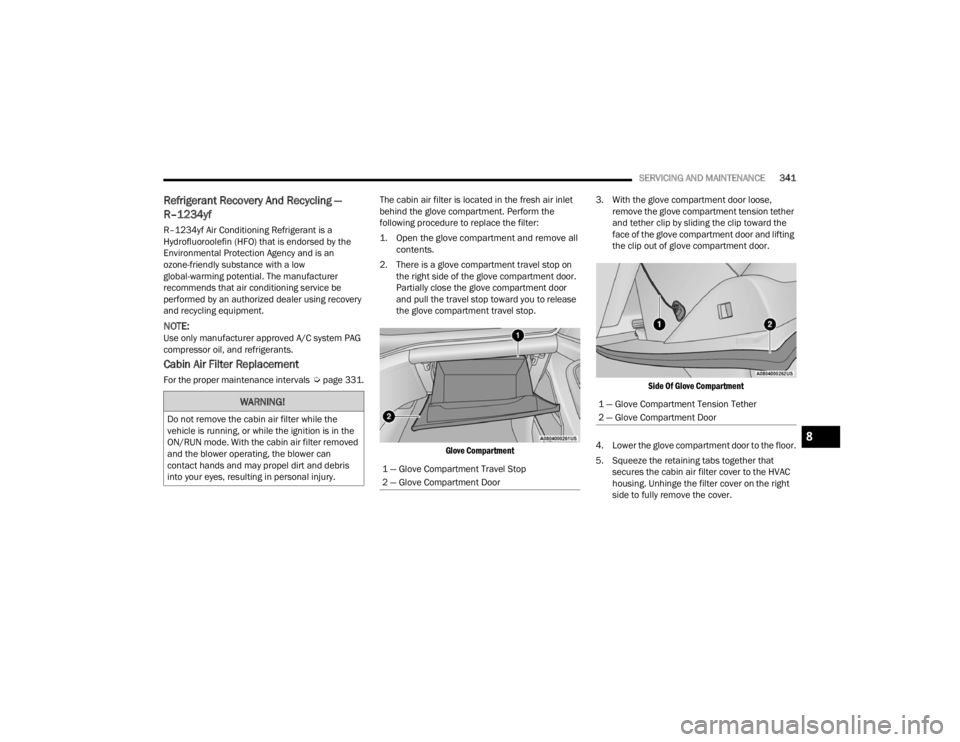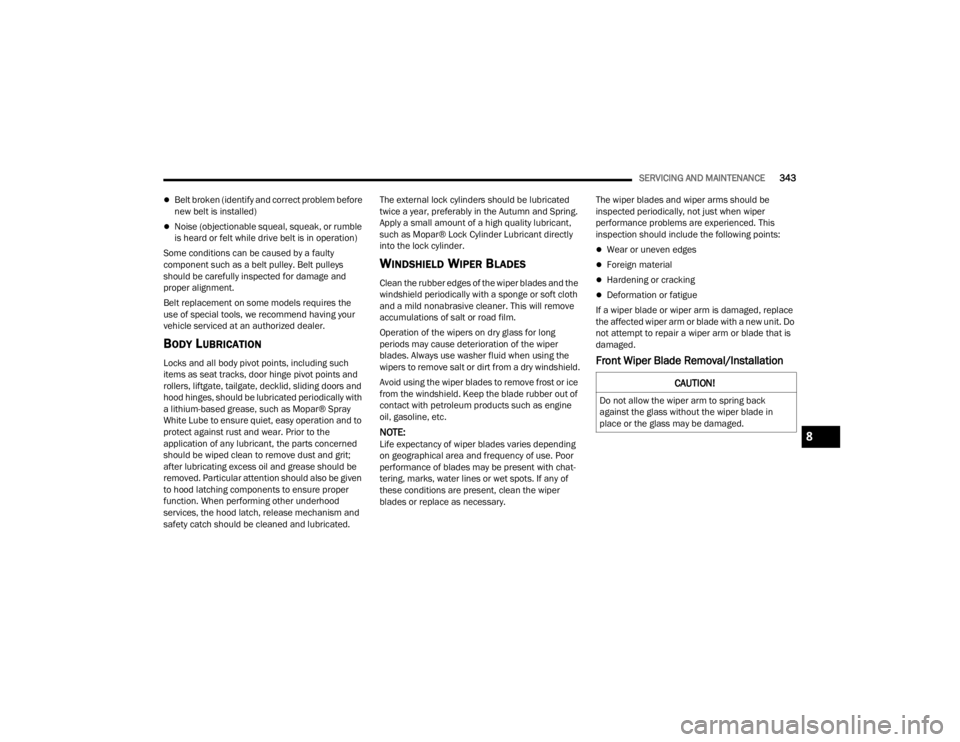ECO mode JEEP GRAND CHEROKEE 2023 Manual PDF
[x] Cancel search | Manufacturer: JEEP, Model Year: 2023, Model line: GRAND CHEROKEE, Model: JEEP GRAND CHEROKEE 2023Pages: 424, PDF Size: 15.48 MB
Page 327 of 424

IN CASE OF EMERGENCY325
FREEING A STUCK VEHICLE
If your vehicle becomes stuck in mud, sand or
snow, it can often be moved using a rocking
motion. Turn the steering wheel right and left to
clear the area around the front wheels. Then, shift
back and forth between DRIVE (D) and REVERSE
(R) while gently pressing the accelerator.
NOTE:Shifts between DRIVE (D) and REVERSE (R) can
only be achieved at wheel speeds of 5 mph
(8 km/h) or less. Whenever the transmission
remains in NEUTRAL (N) for more than two
seconds, you must press the brake pedal to
engage DRIVE (D) or REVERSE (R).
Use the least amount of accelerator pedal
pressure that will maintain the rocking motion
without spinning the wheels or racing the engine.
NOTE:Push the ESC OFF button to place the Electronic
Stability Control (ESC) system in “Partial OFF”
mode, before rocking the vehicle Ú page 251.
Once the vehicle has been freed, push the ESC OFF
button again to restore “ESC On” mode.
WARNING!
Fast spinning tires can be dangerous. Forces
generated by excessive wheel speeds may
cause damage, or even failure, of the axle and
tires. A tire could explode and injure someone.
Do not spin your vehicle's wheels faster than
30 mph (48 km/h) or for longer than 30
seconds continuously without stopping when
you are stuck and do not let anyone near a
spinning wheel, no matter what the speed.
CAUTION!
Racing the engine or spinning the wheels may
lead to transmission overheating and failure.
Allow the engine to idle with the transmission
in NEUTRAL for at least one minute after every
five rocking-motion cycles. This will minimize
overheating and reduce the risk of transmis -
sion failure during prolonged efforts to free a
stuck vehicle.
When “rocking” a stuck vehicle by shifting
between DRIVE and REVERSE, do not spin the
wheels faster than 15 mph (24 km/h), or
drivetrain damage may result.
Revving the engine or spinning the wheels too
fast may lead to transmission overheating and
failure. It can also damage the tires. Do not
spin the wheels above 30 mph (48 km/h)
while in gear (no transmission shifting occur -
ring).
7
23_WL_OM_EN_USC_t.book Page 325
Page 329 of 424

IN CASE OF EMERGENCY327
NOTE:
You must ensure that the Auto Park Brake
Úpage 123 feature is disabled before towing
this vehicle to avoid inadvertent Electric Park
Brake engagement. The Auto Park Brake
feature is enabled or disabled via the customer
programmable features in the Uconnect
Settings.
Vehicles with a discharged battery, or total elec -
trical failure when the Electric Park Brake (EPB)
is engaged, will need a wheel dolly or jack to
raise the rear wheels off the ground when
moving the vehicle onto a flatbed.
The Safehold feature will engage the Electric
Park Brake whenever the driver's door is
opened (if the battery is connected, ignition is
ON, transmission is not in PARK, and brake
pedal is released). If you are towing this vehicle
with the ignition in the ON/RUN mode, you must
manually disable the Electric Park Brake each
time the driver's door is opened by pressing the
brake pedal and then releasing the EPB. If you must use the accessories (wipers,
defrosters, etc.) while being towed, the ignition
must be in the ON/RUN mode.
If the vehicle's battery is discharged, instructions
on shifting the automatic transmission out of PARK
(P) in order to move the vehicle Ú
page 323.
REAR-WHEEL DRIVE MODELS
FCA US LLC recommends towing your vehicle with
all four wheels OFF the ground using a flatbed.
If flatbed equipment is not available, and the
transmission is operable, the vehicle may be towed
(with rear wheels off the ground) under the
following conditions:
The transmission must be in NEUTRAL (N). For
instructions on shifting the transmission to
NEUTRAL (N) when the engine is off
Ú page 323.
The towing speed must not exceed 30 mph
(48 km/h).
The towing distance must not exceed 30 miles
(48 km).
CAUTION!
Do not use sling type equipment when towing.
Vehicle damage may occur.
When securing the vehicle to a flat bed truck,
do not attach to front or rear suspension
components. If vehicle is equipped with
Quadra-lift air suspension, secure vehicle only
with tire/wheel straps (no suspension compo -
nents or body) to prevent air suspension from
adjusting during towing against securement
straps and causing damage. Damage to your
vehicle may result from improper towing.
CAUTION!
Towing faster than 30 mph (48 km/h) or
farther than 30 miles (48 km) with rear
wheels on the ground can cause severe trans -
mission damage. Damage from improper
towing is not covered under the New Vehicle
Limited Warranty.
7
23_WL_OM_EN_USC_t.book Page 327
Page 330 of 424

328IN CASE OF EMERGENCY
If the transmission is not operable, or the vehicle
must be towed faster than 30 mph (48 km/h) or
farther than 30 miles (48 km), tow with the rear
wheels OFF the ground. Acceptable methods are to
tow the vehicle on a flatbed, or with the front
wheels raised and the rear wheels on a towing
dolly, or (when using a suitable steering wheel
stabilizer to hold the front wheels in the straight
position) with the rear wheels raised and the front
wheels ON the ground.
FOUR-WHEEL DRIVE MODELS
FCA US LLC recommends towing with all wheels
OFF the ground. Acceptable methods are to tow
the vehicle on a flatbed or with one end of the
vehicle raised and the opposite end on a towing
dolly.
If flatbed equipment is not available, and the
transfer case is operable, vehicles with a
two-speed transfer case may be towed (in the
forward direction, with ALL wheels on the ground),
IF the transfer case is in NEUTRAL (N) and the
transmission is in PARK Úpage 195. Vehicles equipped with a single-speed transfer
case have no NEUTRAL (N) position, and therefore
must
be towed will all four wheels OFF the ground.
EMERGENCY TOW HOOKS —
I
F EQUIPPED
If your vehicle is equipped with tow hooks, there
will be two mounted on the front of the vehicle and
one in the rear. The rear tow hook will be located
on the driver's side of the vehicle.
Front Tow Hooks
CAUTION!
Front or rear wheel lifts must not be used (if
the remaining wheels are on the ground).
Internal damage to the transmission or
transfer case will occur if a front or rear wheel
lift is used when towing.
Towing this vehicle in violation of the
approved requirements can cause severe
transmission and/or transfer case damage.
Damage from improper towing is not covered
under the New Vehicle Limited Warranty.
CAUTION!
Tow hooks are for emergency use only, to rescue
a vehicle stranded off road. Do not use tow
hooks for tow truck hookup or highway towing.
You could damage your vehicle.
23_WL_OM_EN_USC_t.book Page 328
Page 343 of 424

SERVICING AND MAINTENANCE341
Refrigerant Recovery And Recycling —
R–1234yf
R–1234yf Air Conditioning Refrigerant is a
Hydrofluoroolefin (HFO) that is endorsed by the
Environmental Protection Agency and is an
ozone-friendly substance with a low
global-warming potential. The manufacturer
recommends that air conditioning service be
performed by an authorized dealer using recovery
and recycling equipment.
NOTE:Use only manufacturer approved A/C system PAG
compressor oil, and refrigerants.
Cabin Air Filter Replacement
For the proper maintenance intervals Úpage 331. The cabin air filter is located in the fresh air inlet
behind the glove compartment. Perform the
following procedure to replace the filter:
1. Open the glove compartment and remove all
contents.
2. There is a glove compartment travel stop on the right side of the glove compartment door.
Partially close the glove compartment door
and pull the travel stop toward you to release
the glove compartment travel stop.
Glove Compartment
3. With the glove compartment door loose,
remove the glove compartment tension tether
and tether clip by sliding the clip toward the
face of the glove compartment door and lifting
the clip out of glove compartment door.
Side Of Glove Compartment
4. Lower the glove compartment door to the floor.
5. Squeeze the retaining tabs together that secures the cabin air filter cover to the HVAC
housing. Unhinge the filter cover on the right
side to fully remove the cover.
WARNING!
Do not remove the cabin air filter while the
vehicle is running, or while the ignition is in the
ON/RUN mode. With the cabin air filter removed
and the blower operating, the blower can
contact hands and may propel dirt and debris
into your eyes, resulting in personal injury.
1 — Glove Compartment Travel Stop
2 — Glove Compartment Door
1 — Glove Compartment Tension Tether
2 — Glove Compartment Door
8
23_WL_OM_EN_USC_t.book Page 341
Page 345 of 424

SERVICING AND MAINTENANCE343
Belt broken (identify and correct problem before
new belt is installed)
Noise (objectionable squeal, squeak, or rumble
is heard or felt while drive belt is in operation)
Some conditions can be caused by a faulty
component such as a belt pulley. Belt pulleys
should be carefully inspected for damage and
proper alignment.
Belt replacement on some models requires the
use of special tools, we recommend having your
vehicle serviced at an authorized dealer.
BODY LUBRICATION
Locks and all body pivot points, including such
items as seat tracks, door hinge pivot points and
rollers, liftgate, tailgate, decklid, sliding doors and
hood hinges, should be lubricated periodically with
a lithium-based grease, such as Mopar® Spray
White Lube to ensure quiet, easy operation and to
protect against rust and wear. Prior to the
application of any lubricant, the parts concerned
should be wiped clean to remove dust and grit;
after lubricating excess oil and grease should be
removed. Particular attention should also be given
to hood latching components to ensure proper
function. When performing other underhood
services, the hood latch, release mechanism and
safety catch should be cleaned and lubricated. The external lock cylinders should be lubricated
twice a year, preferably in the Autumn and Spring.
Apply a small amount of a high quality lubricant,
such as Mopar® Lock Cylinder Lubricant directly
into the lock cylinder.
WINDSHIELD WIPER BLADES
Clean the rubber edges of the wiper blades and the
windshield periodically with a sponge or soft cloth
and a mild nonabrasive cleaner. This will remove
accumulations of salt or road film.
Operation of the wipers on dry glass for long
periods may cause deterioration of the wiper
blades. Always use washer fluid when using the
wipers to remove salt or dirt from a dry windshield.
Avoid using the wiper blades to remove frost or ice
from the windshield. Keep the blade rubber out of
contact with petroleum products such as engine
oil, gasoline, etc.
NOTE:Life expectancy of wiper blades varies depending
on geographical area and frequency of use. Poor
performance of blades may be present with chat
-
tering, marks, water lines or wet spots. If any of
these conditions are present, clean the wiper
blades or replace as necessary. The wiper blades and wiper arms should be
inspected periodically, not just when wiper
performance problems are experienced. This
inspection should include the following points:
Wear or uneven edges
Foreign material
Hardening or cracking
Deformation or fatigue
If a wiper blade or wiper arm is damaged, replace
the affected wiper arm or blade with a new unit. Do
not attempt to repair a wiper arm or blade that is
damaged.
Front Wiper Blade Removal/Installation
CAUTION!
Do not allow the wiper arm to spring back
against the glass without the wiper blade in
place or the glass may be damaged.
8
23_WL_OM_EN_USC_t.book Page 343
Page 386 of 424

384SERVICING AND MAINTENANCE
Run Flat Tires — If Equipped
Run Flat tires allow you the capability to drive
50 miles (80 km) at 50 mph (80 km/h) after a
rapid loss of inflation pressure. This rapid loss of
inflation is referred to as the Run Flat mode. A Run
Flat mode occurs when the tire inflation pressure is
of/or below 14 psi (96 kPa). Once a Run Flat tire
reaches the Run Flat mode it has limited driving
capabilities and needs to be replaced immediately.
A Run Flat tire is not repairable. When a Run Flat
tire is changed after being driven in a Run Flat
mode 14 psi (96 kPa) condition, please replace the
TPMS sensor as it is not designed to be reused.
NOTE:TPMS sensor must be replaced after driving the
vehicle on a flat tire condition.
It is not recommended driving a vehicle loaded at
full capacity or to tow a trailer while a tire is in the
Run Flat mode.
See the Tire Pressure Monitoring System section
for more information Úpage 264.
Tire Spinning
When stuck in mud, sand, snow, or ice conditions,
do not spin your vehicle's wheels above 30 mph
(48 km/h) or for longer than 30 seconds
continuously without stopping.
For further information Ú page 325.
Tread Wear Indicators
Tread wear indicators are in the original equipment
tires to help you in determining when your tires
should be replaced.
Tire Tread
These indicators are molded into the bottom of the
tread grooves. They will appear as bands when the
tread depth becomes 1/16 of an inch (1.6 mm).
When the tread is worn to the tread wear
indicators, the tire should be replaced.
For further information Ú
page 385.
Life Of Tire
The service life of a tire is dependent upon varying
factors including, but not limited to:
Driving style
Tire pressure - Improper cold tire inflation pres -
sures can cause uneven wear patterns to
develop across the tire tread. These abnormal
wear patterns will reduce tread life, resulting in
the need for earlier tire replacement.
Distance driven
Performance tires, tires with a speed rating of V
or higher, and Summer tires typically have a
reduced tread life. Rotation of these tires per
the vehicle scheduled maintenance is highly
recommended.
WARNING!
Fast spinning tires can be dangerous. Forces
generated by excessive wheel speeds may
cause tire damage or failure. A tire could
explode and injure someone. Do not spin your
vehicle's wheels faster than 30 mph (48 km/h)
for more than 30 seconds continuously when
you are stuck, and do not let anyone near a
spinning wheel, no matter what the speed.
1 — Tread Wear Indicators
WARNING!
Tires and the spare tire should be replaced after
six years, regardless of the remaining tread.
Failure to follow this warning can result in sudden
tire failure. You could lose control and have a
collision resulting in serious injury or death.
23_WL_OM_EN_USC_t.book Page 384
Page 400 of 424

398TECHNICAL SPECIFICATIONS
REFORMULATED GASOLINE
Many areas of the country require the use of
cleaner burning gasoline referred to as
“reformulated gasoline”. Reformulated gasoline
contains oxygenates and are specifically blended
to reduce vehicle emissions and improve air
quality.
The use of reformulated gasoline is recommended.
Properly blended reformulated gasoline will
provide improved performance and durability of
engine and fuel system components.
MATERIALS ADDED TO FUEL
Besides using unleaded gasoline with the proper
octane rating, gasolines that contain detergents,
corrosion and stability additives are
recommended. Using gasolines that have these
additives will help improve fuel economy, reduce
emissions, and maintain vehicle performance.
Designated TOP TIER Detergent Gasoline
contains a higher level of detergents to
further aide in minimizing engine and
fuel system deposits. When available,
the usage of TOP TIER Detergent Gasoline is
recommended. Visit
www.toptiergas.com for a list
of TOP TIER Detergent Gasoline retailers. Indiscriminate use of fuel system cleaning agents
should be avoided. Many of these materials
intended for gum and varnish removal may contain
active solvents or similar ingredients. These can
harm fuel system gasket and diaphragm materials.
GASOLINE/OXYGENATE BLENDS
Some fuel suppliers blend unleaded gasoline with
oxygenates such as ethanol.
Problems that result from using gasoline
containing more than 15% ethanol (E-15) or
gasoline containing methanol are not the
responsibility of the manufacturer and may void or
not be covered under New Vehicle Limited
Warranty.
DO NOT USE E-85 IN NON-FLEX FUEL
V
EHICLES
Non-Flex Fuel Vehicles (FFV) are compatible with
gasoline containing up to 15% ethanol (E-15). Use
of gasoline with higher ethanol content may void
the New Vehicle Limited Warranty.
If a Non-FFV vehicle is inadvertently fueled with
E-85 fuel, the engine will have some or all of these
symptoms:
Operate in a lean mode.
OBD II Malfunction Indicator Light on.
Poor engine performance.
Poor cold start and cold drivability.
Increased risk for fuel system component corro -
sion.
CNG AND LP FUEL SYSTEM
M
ODIFICATIONS
Modifications that allow the engine to run on
Compressed Natural Gas (CNG) or Liquid Propane
(LP) may result in damage to the engine,
emissions, and fuel system components. Problems
that result from running CNG or LP are not the
responsibility of the manufacturer and may void or
not be covered under the New Vehicle Limited
Warranty.
CAUTION!
DO NOT use E-85, gasoline containing methanol,
or gasoline containing more than 15% ethanol
(E-15). Use of these blends may result in starting
and drivability problems, damage critical fuel
system components, cause emissions to exceed
the applicable standard, and/or cause the
Malfunction Indicator Light to illuminate. Please
observe pump labels as they should clearly
communicate if a fuel contains greater than
15% ethanol (E-15).
23_WL_OM_EN_USC_t.book Page 398
Page 419 of 424

417
Remote Keyless Entry
...................................... 18Arm The Alarm............................................. 26Disarm The Alarm........................................ 27Programming Additional Key Fobs.............. 21Remote Sound System (Radio) Control......... 228Remote Starting Exit Remote Start Mode.............................. 25Remote Starting System.................................. 24Replacement Bulbs....................................... 374Replacement Keys........................................... 21Replacement Tires......................................... 385Reporting Safety Defects............................... 406Restraints, Child............................................ 289Restraints, Head.............................................. 47Roll Over Warning............................................ 11Roof Luggage Rack.......................................... 93Rotation, Tires............................................... 391
S
Safety Checks Inside Vehicle......................... 303Safety Checks Outside Vehicle...................... 305Safety Defects, Reporting.............................. 406Safety Information, Tire................................. 374Safety Tips..................................................... 303Safety, Exhaust Gas....................................... 305Schedule, Maintenance................................. 330Screen, Passenger......................................... 228
Seat Belts............................................ 270, 303Adjustable Shoulder Belt.......................... 274Adjustable Upper Shoulder Anchorage..... 274
Adjustable Upper Shoulder Belt Anchorage.. 274
Automatic Locking Retractor (ALR)........... 275Child Restraints........................................ 289Energy Management Feature................... 275Extender................................................... 274Front Seat............................... 270, 271, 273Inspection................................................. 303Lap/Shoulder Belt Operation.................... 273Lap/Shoulder Belt Untwisting................... 273Lap/Shoulder Belts.................................. 271Operating Instructions.............................. 273Pregnant Women...................................... 275Pretensioners........................................... 275Rear Seat................................................. 271Reminder................................ 110, 116, 270Seat Belt Extender.................................... 274Seat Belt Pretensioner............................. 275Seat Belt Reminder.................................. 116Untwisting Procedure............................... 273Seat Belts Maintenance............................... 394Seats.......................................... 36, 41, 42, 45Adjustment........................................... 36, 42Bolster Adjustment...................................... 42Easy Entry.................................................... 43
Extend.........................................................43Heated.........................................................45Massage......................................................44Memory.......................................................34Rear Folding................................................36Reclining......................................................37Seatback Release........................................36Tilting...........................................................36Vented.........................................................46Ventilated....................................................46Second Row USB.............................................78Security Alarm........................................ 26, 111Arm The System...........................................26Disarm The System......................................27Selec-Terrain................................................. 134Sentry Key (Immobilizer)..................................22Sentry Key Replacement..................................21Service Assistance........................................ 403Service Contract............................................ 405Service Manuals........................................... 407Settings................................................ 104, 204Shift Paddles................................................. 130Shifting.......................................................... 126Automatic Transmission.................. 126, 127Shifting Into NEUTRAL (N)............................. 197Shifting Out Of NEUTRAL (N)......................... 198Shoulder Belts.............................................. 27111
23_WL_OM_EN_USC_t.book Page 417
Page 420 of 424

418 Side Distance Warning
.................................. 165Signals, Turn........................................ 116, 305Snow Chains (Tire Chains)............................. 389Snow Tires..................................................... 386Spare Tires................................. 313, 386, 387Speed Control Accel/Decel (ACC Only)............................. 146Sport Mode.................................................... 131Starting................................................... 24, 119Button......................................................... 22Cold Weather............................................ 122Engine Fails To Start................................. 122Remote....................................................... 24Starting And Operating.................................. 119Starting Procedures....................................... 119Steering........................................................... 32Power........................................................ 139Tilt Column.................................................. 32Wheel, Heated............................................. 33Wheel, Tilt................................................... 32Wheel, Voice Recognition............................ 33Steering Wheel Audio Controls...................... 228Steering Wheel Mounted Sound
System Controls............................................ 228Stop/Start................................... 113, 116, 140Storage............................................................ 74Cargo Area.................................................. 90Storage, Vehicle............................................. 392Storing Your Vehicle...................................... 392Streaming...................................................... 234
Sun Roof............................................ 83, 84, 86Opening....................................................... 84Sun Visor......................................................... 51Sunglasses Storage......................................... 75Sunshade Operation................... 76, 84, 85, 86Surround View Camera................................. 181Sway Bar DisconnectElectronic................................................. 133Sway Control, Trailer..................................... 257Symbol Glossary.............................................. 12Synthetic Engine Oil...................................... 339System, Remote Starting................................. 24
T
Telescoping Steering Column.......................... 32Temperature Control, Automatic (ATC)............. 72Third Party Apps............................................ 233Third Row USB................................................. 78Tie Down Hooks, Cargo.................................... 91Tilt Steering Column........................................ 32Tire And Loading Information Placard........... 379Tire Identification Number (TIN).................... 377Tire Markings................................................ 374Tire Safety Information................................. 374Tire Terminology And Definitions.................. 378Tires...................................305, 382, 386, 391Aging (Life Of Tires).................................. 384Air Pressure.............................................. 382Chains...................................................... 389
Changing.................................................. 310Compact Spare......................................... 386General Information........................ 382, 386High Speed............................................... 383Inflation Pressure..................................... 382Life Of Tires.............................................. 384Load Capacity........................................... 379
Pressure Monitoring System (TPMS).. 113, 264
Quality Grading......................................... 391Radial....................................................... 383Replacement............................................ 385Rotation.................................................... 391Run Flat.................................................... 384Safety.............................................. 374, 382Sizes......................................................... 375Snow Tires................................................ 386Spare Tires.............................313, 386, 387Spinning................................................... 384Trailer Towing........................................... 192Tread Wear Indicators.............................. 384Types........................................................ 385Wheel Nut Torque..................................... 396To Open Hood..................................................87Tongue Weight/Trailer Weight............. 186, 191Towing........................................................... 185Disabled Vehicle....................................... 326Guide........................................................ 189Recreational............................................. 195Weight...................................................... 189Towing Behind A Motorhome........................ 195
23_WL_OM_EN_USC_t.book Page 418
Page 424 of 424

Second Edition
23_WL_OM_EN_USC
©2022 FCA US LLC . All Rights Reserved. Tous droits réservés. Jeep is a registered trademark of FCA US LLC . Jeep est une
marque déposée de FCA US LLC . App Store is a registered trademark of Apple Inc. Google Play Store is a registered trademark of Google.
DOWNLOAD THE MOST UP-TO-DATE OWNER’S MANUAL,
RADIO AND WARRANTY BOOKS
owners.mopar.ca
Canada
mopar.com/om
Whether it ’s providing information about specific product features, taking a tour through your vehicle’s heritage, knowing what
steps to take following an accident or scheduling your next appointment, we know you’ll find the app an important extension of
your Jeep® brand vehicle. Simply download the app, select your make and model and enjoy the ride. To get this app, go directly
to the App Store® or Google Play® Store and enter the search keyword “JEEP ” (U.S. residents only).
USA
2023 GRAND CHEROKEE/GRAND CHEROKEE L2023 GRAND CHEROKEE/GRAND CHEROKEE L
OWNER’S MANUAL